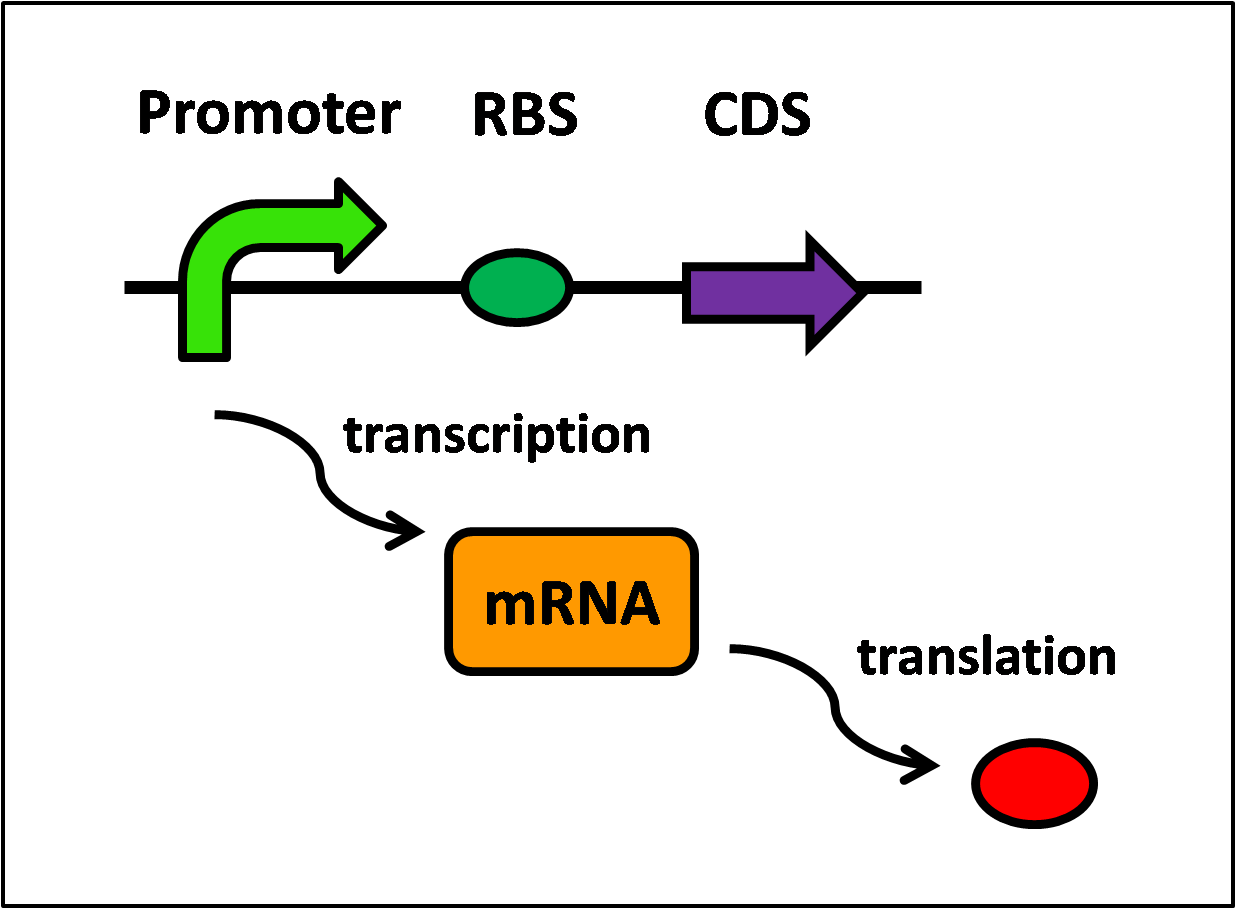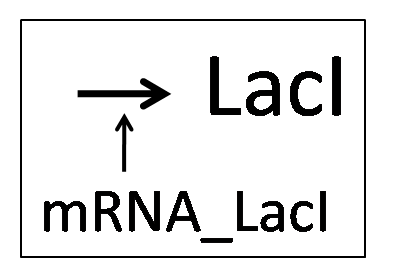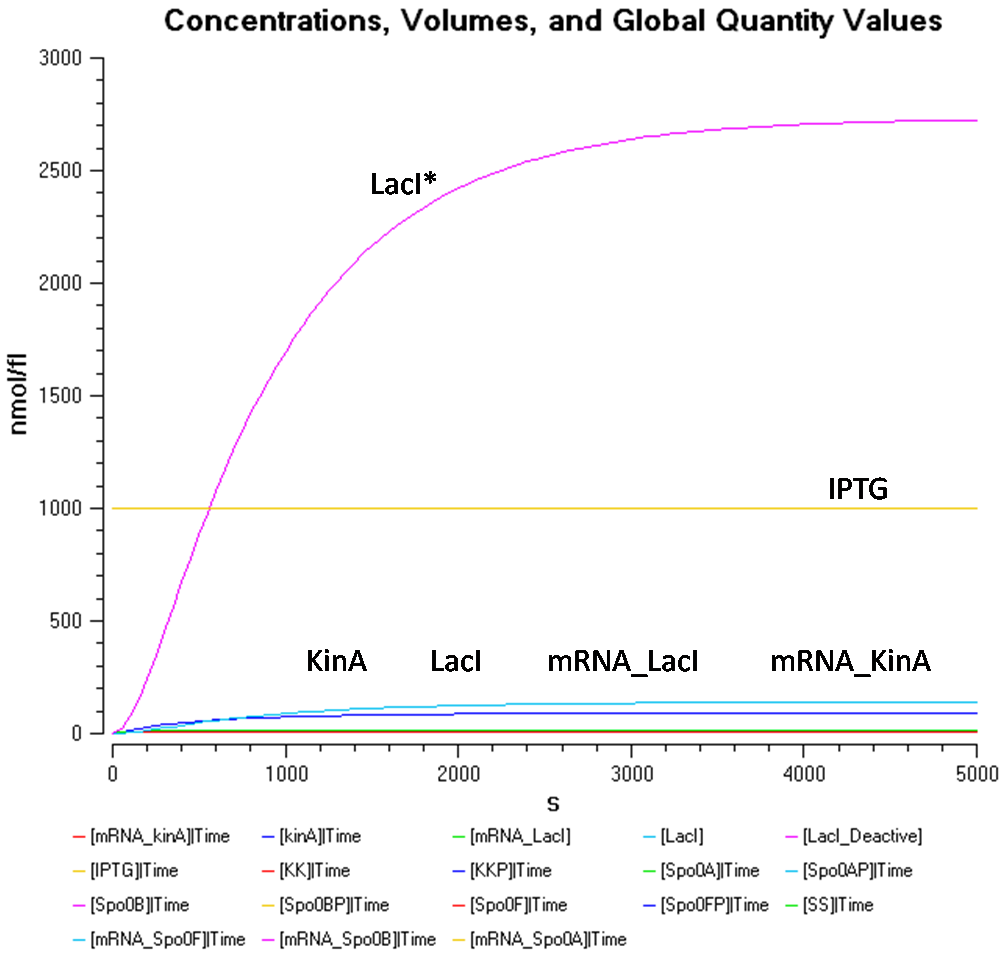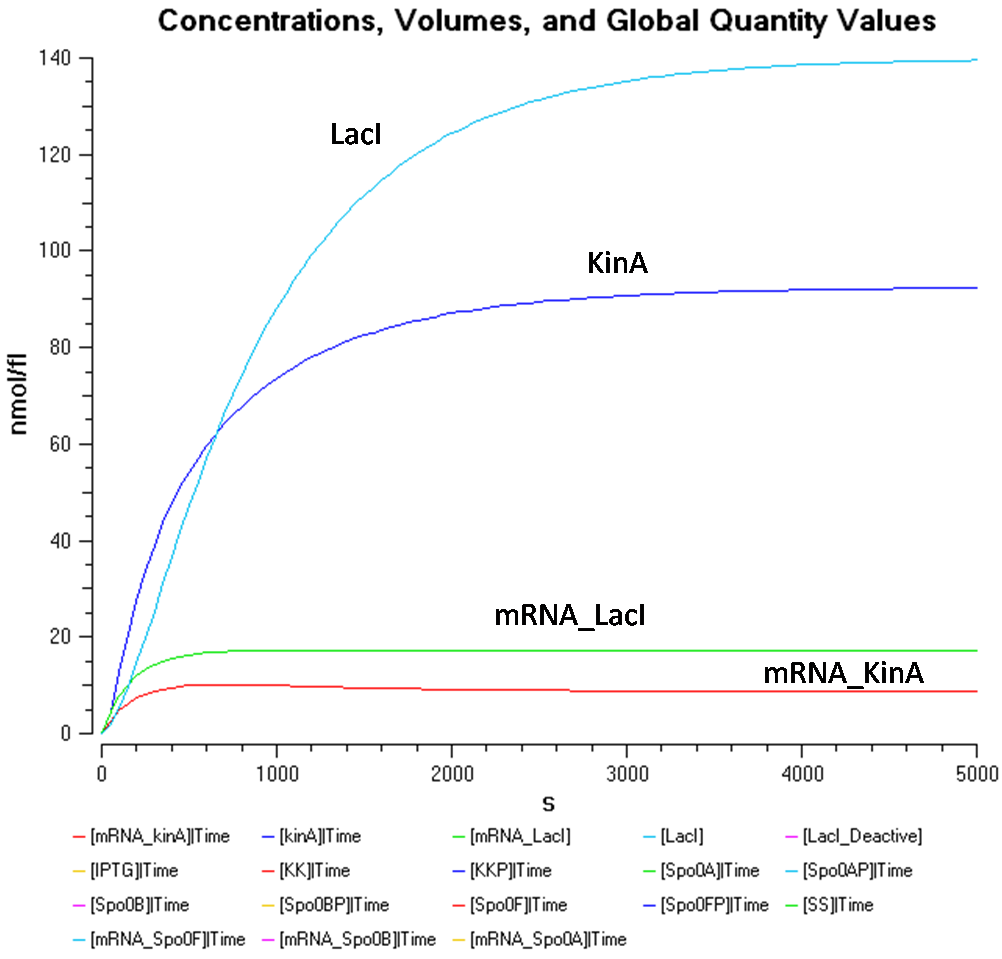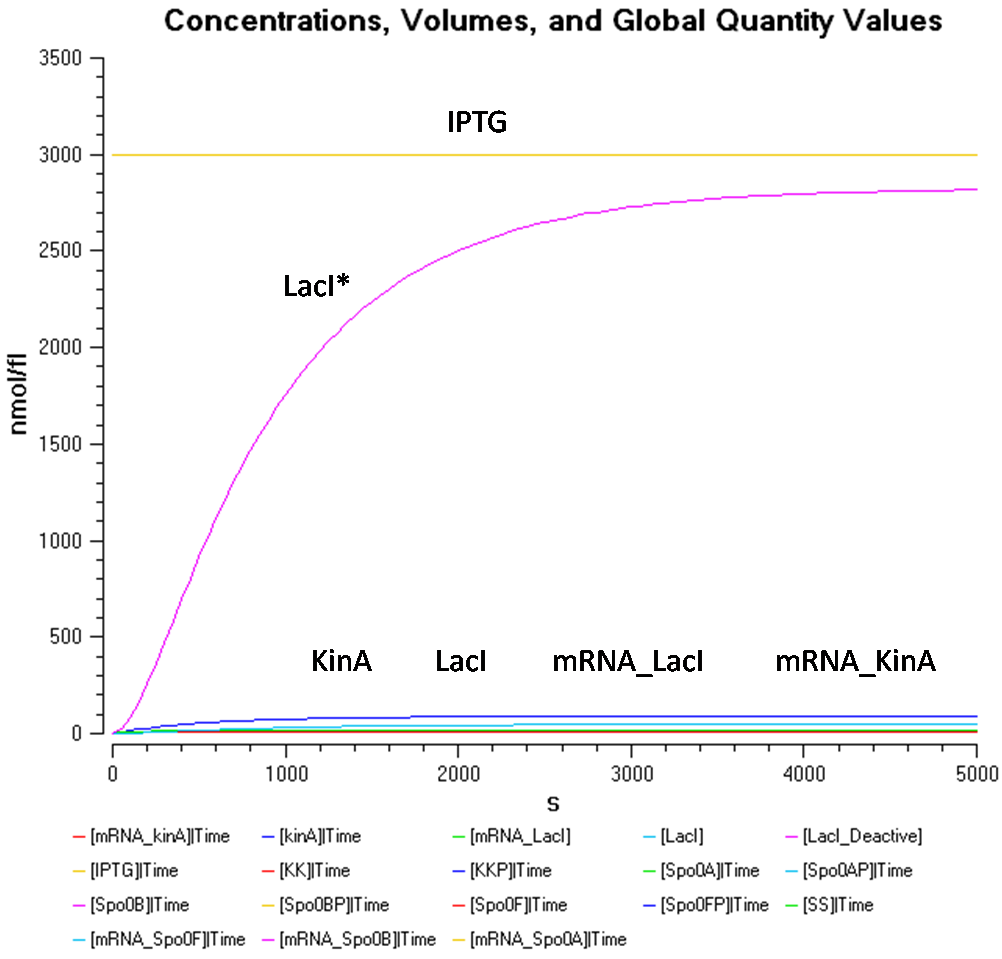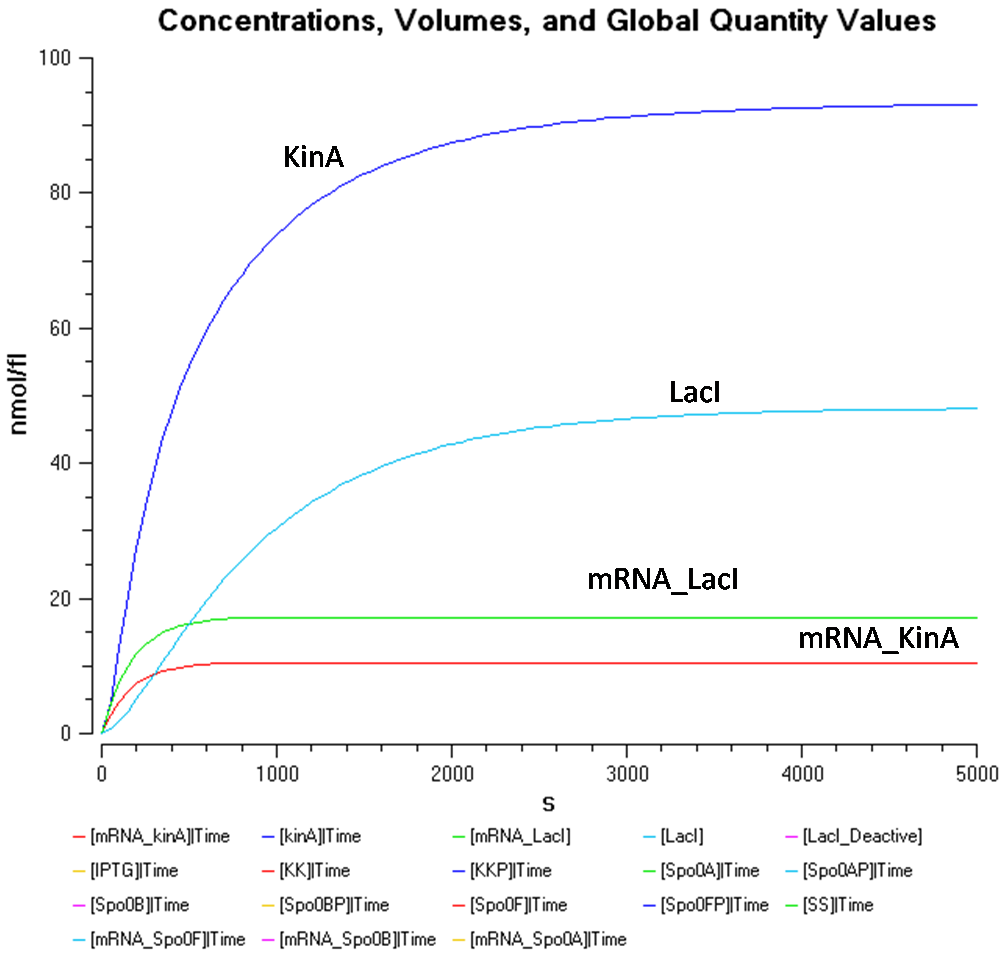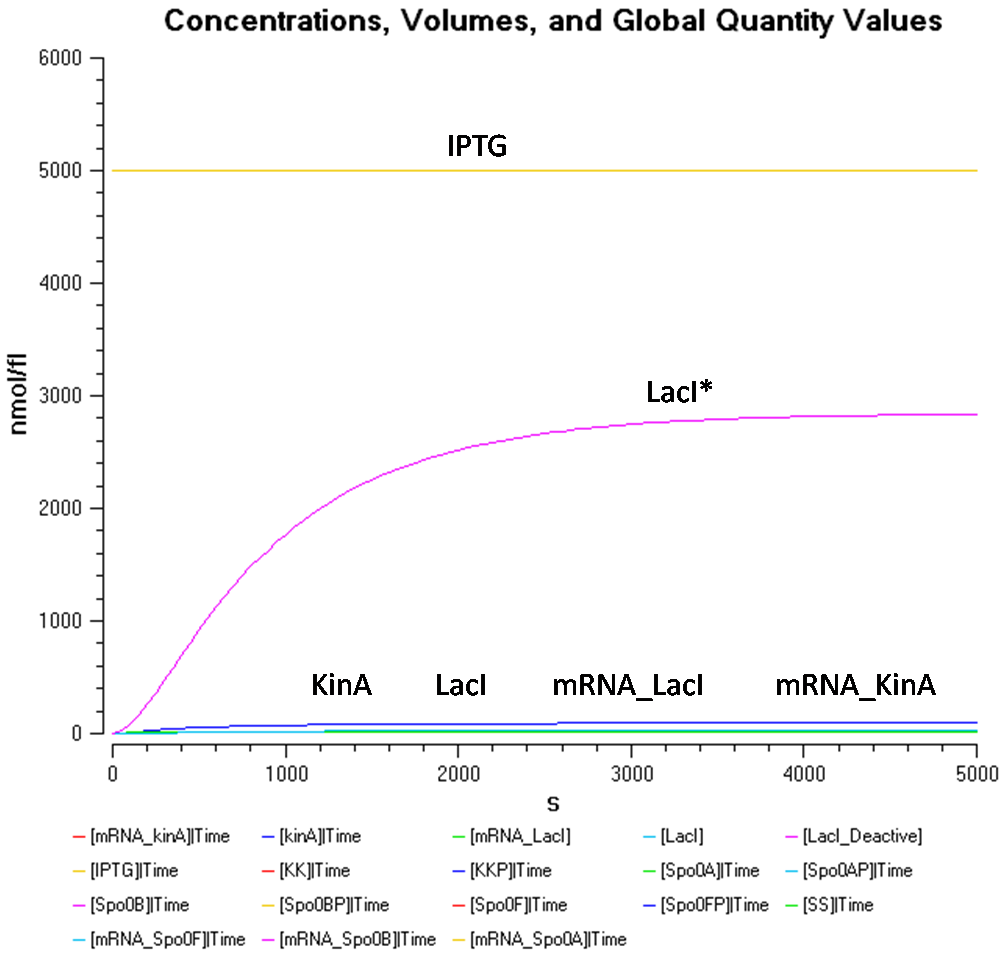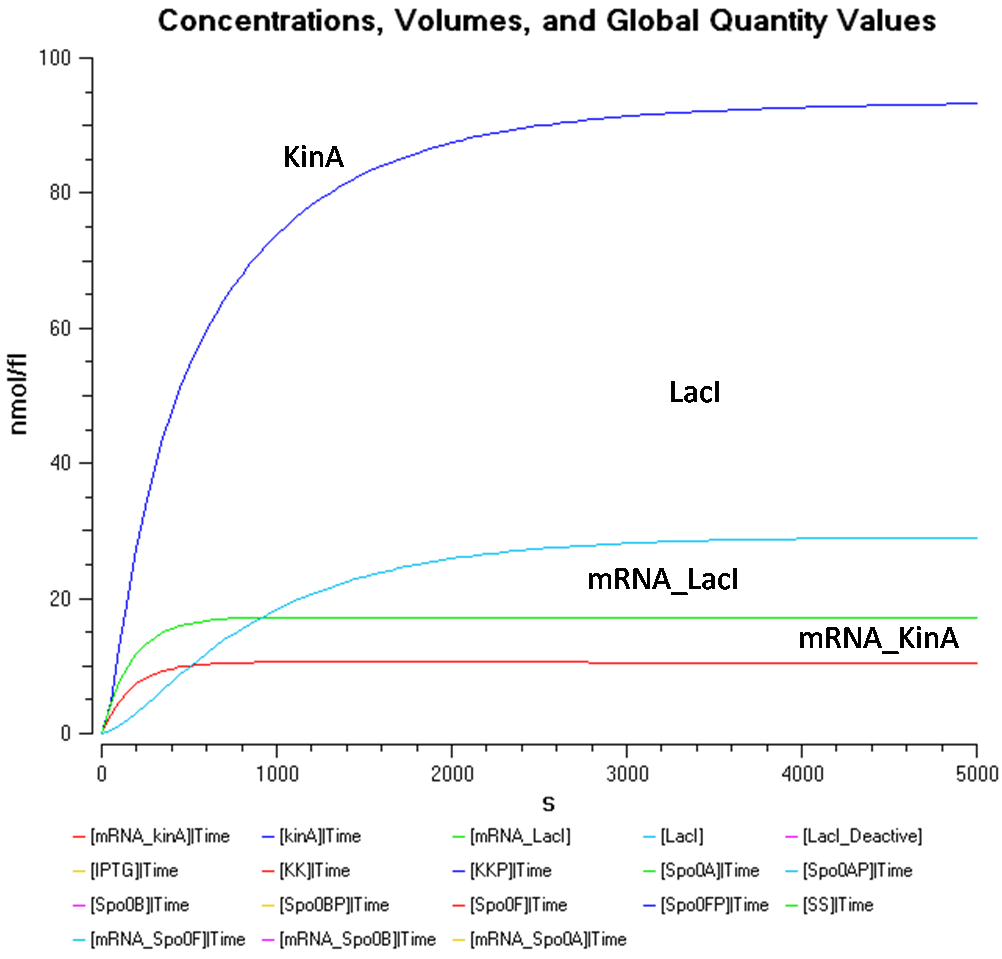Team:Newcastle/Modelling/SporulationTuning
From 2009.igem.org
(→Sporulation Tuning) |
(→KinA Expression Model) |
||
| Line 57: | Line 57: | ||
where mRNA_KinA is inducing the formation of KinA. | where mRNA_KinA is inducing the formation of KinA. | ||
| + | |||
| + | ====Results==== | ||
| + | |||
| + | The above equations were modelled in COPASI, and the following graphs show the behaviour of the system over time at different IPTG concentrations. | ||
| + | |||
| + | |||
| + | ;<u>IPTG concentration = 1000 nmol/fl</u> | ||
| + | |||
| + | [[Image:TeamNewcastleKinAExpPic1.png|center|500px]] | ||
| + | <center>''Figure 1.1''</center> | ||
| + | |||
| + | |||
| + | In Figure 1.1, at a IPTG concentration of 1000nmol/fl, due to the high concentration of LacI*, it is difficult to view the results for the other species, such as, KinA, LacI, mRNA_KinA, and mRNA_LacI as they are all concentrated at the bottom. | ||
| + | |||
| + | |||
| + | [[Image:TeamNewcastleKinAExpPic2.png|center|500px]] | ||
| + | <center>''Figure 1.2''</center> | ||
| + | |||
| + | |||
| + | Figure 1.2 shows the behaviour of KinA, LacI, mRNA_KinA and mRNA_LacI more clearly, at the IPTG concentration of 1000nmol/flu. | ||
| + | |||
| + | From Figure 1.1 and 1.2, it is observed that the concentration of LacI* is significantly higher than the other species when the IPTG concentration is set at 1000nmol/fl. Looking at Figure 1.2, while the concentration of KinA is increasing, it is still lower than that of LacI. | ||
| + | |||
| + | |||
| + | ;<u>IPTG concentration = 3000 nmol/fl</u> | ||
| + | |||
| + | [[Image:TeamNewcastleKinAExpPic3.png|center|500px]] | ||
| + | <center>''Figure 2.1''</center> | ||
| + | |||
| + | |||
| + | Comparing Figure 1.1 and 2.1, though the IPTG concentration in Figure 2.1 is 3000nmol/fl, the LacI* concentration is not particularly different. | ||
| + | |||
| + | |||
| + | [[Image:TeamNewcastleKinAExpPic4.png|center|500px]] | ||
| + | <center>''Figure 2.2''</center> | ||
| + | |||
| + | |||
| + | As the IPTG concentration increases from 1000 to 3000nmol/fl, the KinA concentration is greater than the LacI concentration. However, upon a closer look, the KinA concentration did not increase due to the higher IPTG concentration. The KinA concentration is now higher than the LacI concentration because the LacI concentration decreased. | ||
| + | |||
| + | ;<u>IPTG concentration = 5000 nmol/fl</u> | ||
| + | |||
| + | [[Image:TeamNewcastleKinAExpPic5.png|center|500px]] | ||
| + | <center>''Figure 3.1''</center> | ||
| + | |||
| + | |||
| + | Once again, as obsered in Figure 1.1 and 2.1, the concentration of LacI* in Figure 3.1 seems to reach the similar concentrations although the concentration of IPTG has been increased in each case. This seems to say that the concentration of LacI* has reached a threshold concentration. | ||
| + | |||
| + | |||
| + | [[Image:TeamNewcastleKinAExpPic6.png|500px|center]] | ||
| + | <center>''Figure 3.2''</center> | ||
| + | |||
| + | |||
| + | The KinA concentration in Figure 3.2 is greater than that of LacI once again. However, KinA concentration seems to be stagnant at approximately 90nmol/fl, while the LacI concentration constantly decreases with increased IPTG concentration. There, the IPTG concentration only seems to affect the LacI concentration. | ||
| + | |||
{{:Team:Newcastle/Footer}} | {{:Team:Newcastle/Footer}} | ||
{{:Team:Newcastle/Right}} | {{:Team:Newcastle/Right}} | ||
Revision as of 16:00, 21 October 2009
Sporulation Tuning
KinA Expression Model
Under normal conditions, LacI represses KinA.
However, in the presence of IPTG, KinA can be expressed, as IPTG binds to LacI, deactivating it. Equations (a) and (b) describes how IPTG binds to LacI, forming LacI*, which is the deactivated form of LacI
Over time, the deactivated form of LacI, LacI* may degrade. This is also taken into consideration while building the model.
Protein synthesis requires two steps, transcription and translation, and is further illustrated in Figure 1, below.
Referring to Figure 1, the following equations can be written:
- Transcription of LacI,
- Translation of LacI,
where mRNA_LacI is inducing the formation of LacI.
- Transcription of KinA,
where LacI is repressing mRNA_KinA, therefore a lower concentration of LacI would result in a higher concentration of mRNA_KinA.
- Translation of KinA,
where mRNA_KinA is inducing the formation of KinA.
Results
The above equations were modelled in COPASI, and the following graphs show the behaviour of the system over time at different IPTG concentrations.
- IPTG concentration = 1000 nmol/fl
In Figure 1.1, at a IPTG concentration of 1000nmol/fl, due to the high concentration of LacI*, it is difficult to view the results for the other species, such as, KinA, LacI, mRNA_KinA, and mRNA_LacI as they are all concentrated at the bottom.
Figure 1.2 shows the behaviour of KinA, LacI, mRNA_KinA and mRNA_LacI more clearly, at the IPTG concentration of 1000nmol/flu.
From Figure 1.1 and 1.2, it is observed that the concentration of LacI* is significantly higher than the other species when the IPTG concentration is set at 1000nmol/fl. Looking at Figure 1.2, while the concentration of KinA is increasing, it is still lower than that of LacI.
- IPTG concentration = 3000 nmol/fl
Comparing Figure 1.1 and 2.1, though the IPTG concentration in Figure 2.1 is 3000nmol/fl, the LacI* concentration is not particularly different.
As the IPTG concentration increases from 1000 to 3000nmol/fl, the KinA concentration is greater than the LacI concentration. However, upon a closer look, the KinA concentration did not increase due to the higher IPTG concentration. The KinA concentration is now higher than the LacI concentration because the LacI concentration decreased.
- IPTG concentration = 5000 nmol/fl
Once again, as obsered in Figure 1.1 and 2.1, the concentration of LacI* in Figure 3.1 seems to reach the similar concentrations although the concentration of IPTG has been increased in each case. This seems to say that the concentration of LacI* has reached a threshold concentration.
The KinA concentration in Figure 3.2 is greater than that of LacI once again. However, KinA concentration seems to be stagnant at approximately 90nmol/fl, while the LacI concentration constantly decreases with increased IPTG concentration. There, the IPTG concentration only seems to affect the LacI concentration.
News
Events
- 20 – 21 June 2009 - Europe workshop (London)
- 23 – 24 June 2009 - UK iGEM meetup (Edinburgh)
- 23 October Practice Presentation (Newcastle)
- 23 October T-shirts are ready
- 27 October Practice Presentation (Sunderland)
- 27 October Poster is ready
- 30 October – 2 November 2009 - Jamboree (Boston)
Social Net
- Newcastle iGEM Twitter
- [http://www.facebook.com/home.php#/group.php?gid=131709337641 Newcastle on Facebook]
- [http://www.youtube.com/user/newcastle2009igem Newcastle Youtube Channel]
 "
"


